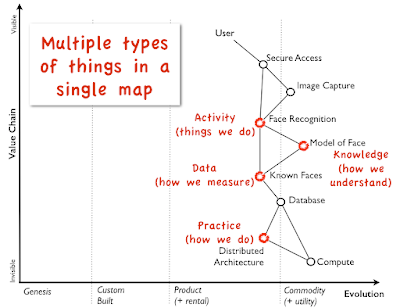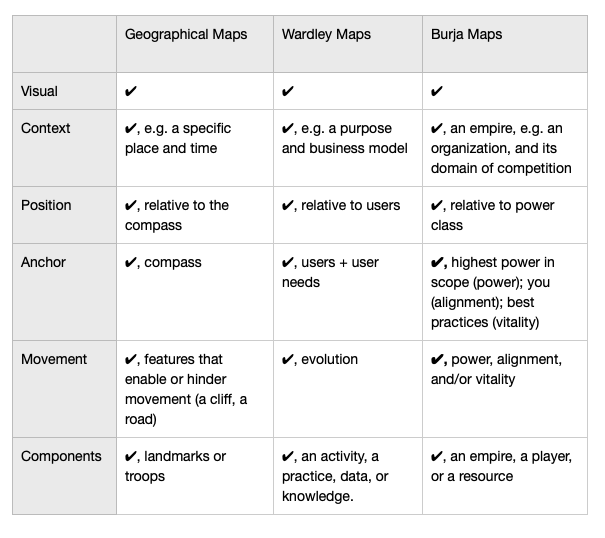- Towards Burja Mapping
- Why Map Power?
- Foundations of Burja Mapping
- On the Use and Abuse of SWOT Diagrams
- Mapping Moneyball
- Mapping Resources of Power
Now that we’ve given a more thorough account of why Burja Mapping is useful as a complement to other forms of strategic thinking, let’s dive deeper into the details of combining mapping with Empire Theory.
In his book, Simon gives an account of what the basic elements of any map are, and proceeds to justify the use of a kind of topological charting in strategy and business. Let’s review that account and extend it to Empire Theory and Burja Mapping.
What is a map, really?
First, let’s discuss use the simple case of geographical maps to discuss the universal elements of maps that Simon identified. Maps are visual, which you can see on paper, on a computer, or in your mind’s eye. Maps have anchors (the compass), position relative to the anchor (relative to the compass, e.g. orientation by cardinal direction or GPS), and “features that enable or hinder movement (a cliff, a road).” Different things can be represented on maps (e.g. landmarks, borders, troops).

Geographical Maps
In a Wardley map, the anchor is the user need; position is shown with a value chain and visibility to the user. Movement is shown with evolution, which Simon identified and can be quickly understood by a glance at the evolutionary characteristics cheat sheet.

Finally, Wardley maps can have different types of components: activities, practices, data, and knowledge.

Wardley maps are dense, which can make them seem overly complicated, intimidating, or even useless. But geographical maps are similarly dense, and similarly varied, and yet we use them in our daily lives. It is quite possible to achieve similar levels of literacy and competency with Wardley mapping, and, as we shall see, with Burja Mapping as well.
However, unlike geographical maps (ubiquitous) or Wardley maps (less common, but well defined), Burja maps are functionally brand new and therefore not well defined. Power mapping is, I think, in the custom stage of evolution. I make these maps in one way, and you’ll probably do it differently. That’s ok! I encourage you to do so. Let me know what variations you’re finding. That said, here’s how I currently understand Burja Maps.
Burja Maps also have each of these six components. Burja Maps are visual. They have a specific context, e.g. a specific team or organization (in Empire Theory terms, empire). Power in that empire will usually revolve around a specific domain of competition. They have a position (High, Mid, Low, or Out), relative to the highest power class. They have at least three forms of movement: power, vitality, and alignment (alliance and competition). Finally, they have specific types of components: an empire, player, or resource. Here is a chart that compares these elements in detail, across these three kinds of maps:

Context: Empires and Domains of Competition
The context of a map is a specific empire, with a domain of competition. A domain of competition is “a region in which players compete for scarce resources.”
Accordingly, you may find it useful to give your Burja Maps a title with the name of the relevant empire, and a subtitle with the domain of competition, e.g. “C Suite of AcmeCorp, status in the form of position + salaries,” or, to use Burja’s stock example, “the oil industry, the allegiance of a particular congressman.”
Anchors and Movement
There are three forms of movement, each with a separate anchor:
- Power (highest power in scope)
- Alignment (you, or a given player)
- Vitality (best practices)
The first form of movement is on the y-axis, the power class. Movement here consists of a player or empire gaining or losing power (or leaving an empire entirely). The anchor is the “highest” player or empire in a given scope of a map. This is because, according to Burja, power is Pareto-distributed: “The most powerful players are orders of magnitude more powerful than all other players.”
As with Wardley Mapping, you can always zoom in or out, since empires are fractal. Here’s an example Burja gives in Great Founder Theory:
Like empires, power classes are fractal. The same actor can be classified as low, mid, or high depending on the frame of reference. For example, a parish priest in New York might be low if considering the entire Catholic church, mid if considering the Archdiocese of New York, and high if considering the priest’s parish itself.
You will often want to map multiple empires, with multiple points of reference. For example, as Burja points out, “it will often make sense to model high as an empire in itself”:
…there are naturally occurring coordination mechanisms that cause high to be its own cluster of coordination within an empire, and there are usually a small number of individuals in high that coordinate the other high players (a high within high).
Zooming in or out shifts who or what the relevant anchor is, but the anchor for this movement is always the highest in the given empire.
There is also movement on the default x-axis, vitality. Vitality tracks whether a player is live or dead:
A live player is a person or a tightly coordinated group of people that is able to do things they have not done before. A dead player is a person or a group of people that is working off a script, incapable of doing new things.
A player can become more “alive” or “dead,” so vitality is non-binary and therefore there is movement here as well. The anchor is the relevant script, the way things have been done before, best practices, etc. These best practices might be mapped by Wardley or Maturity maps. If you’re following the script, you’re dead. If you’re doing novel things, you’re live.
The last form of movement is alignment. This is in relation to you or a specific player. By default, this is you (literally) and yours (your team, organization, etc.) but of course could be any player at all, e.g. a historical figure, a competitor, even someone from a work of fiction. Movement can be alliance or opposition; there are many different kinds of alignment gameplay which are variations on these two main directions. Whether players form alliances or enmities will naturally tend to have effects on the distribution of power within empires (vertical movement).
Other players come in three forms — ally, neutral, and enemy — with two varieties each:

The distinction in kinds of allies, between broad and narrow, comes from Empire Theory: “Two players can cooperate in one domain while battling in a different domain. I call this a narrow alliance. When two players are coordinating to achieve most of their goals and no longer contest one another, I call it a broad alliance.”
Neutral forces can be bland — which is to say, friendly but irrelevant- or, worse, an obstacle, whether intentional or not. This may also include people whose alignment may be unknown.
Enemies can be competitive (good natured, unlikely to kill you for example, but not acting in your best interests) or sworn (actively pursuing things that attack you). Here the distinction that Burja makes between unlimited and limited actions is relevant and useful:
Unlimited actions are competitive actions that do not pertain directly to the competitive domain or do not stick to the rules… Limited actions are competitive actions that pertain directly to a given domain of competition and stick to the “rules.”
You need to know: will the enemy stick to the domain at hand, or not? Will the enemy play by the rules, or not?
Colors provide a useful way to indicate a third dimension on a two dimensional map. In Burja Mapping, they reflect a simple polarity of alliance: “us” vs. “them.” I include six colors in the diagram above, but I expect most people will stick to three non-default colors in their Burja Maps: green (towards alliance), yellow (obstacle), and red (enemy, towards attack and defense). Above all, this form of movement is simple, towards or away; gameplay is complex, and context-specific. Who do you want to align, co-operate, and coordinate with as a team? Who do you want to avoid, attack, or defend, treating as enemies or obstacles? How will you do it?
The maps that I’ve made represent these three dimensions in two dimensions. I’ve used power as the y axis and vitality as the x axis, with colors representing the third dimension, alignment. However, you could just as easily make alternate kinds of maps. For example, you might swap alignment into the x axis, as this predecessor of Burja Mapping does (hat tip to John Grant for finding this!). In any case, Burja’s Empire Theory provides a valuable starting point for whatever power maps you end up making.

